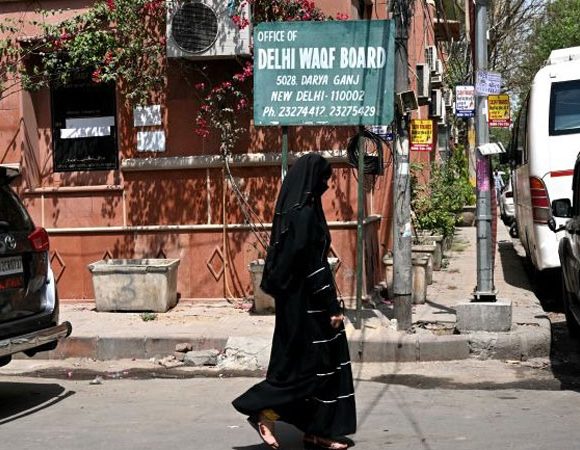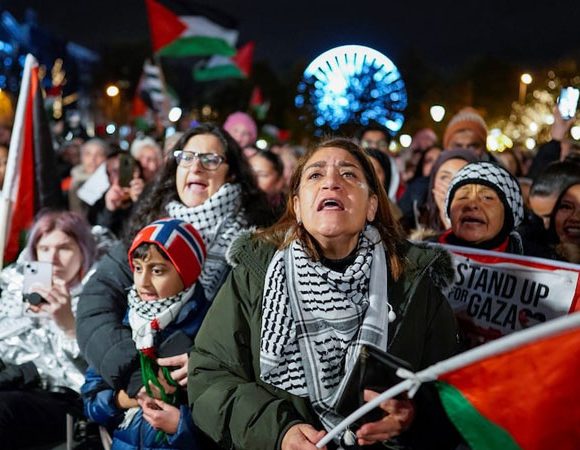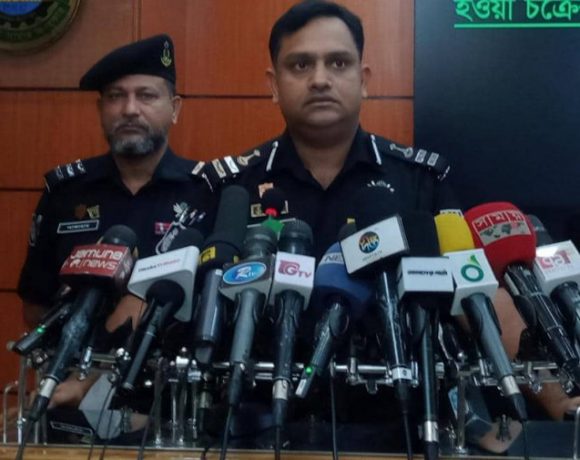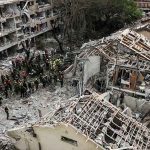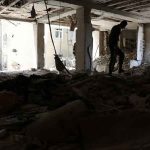Civilians in firing line as conflict returns to Myanmar’s Rakhine
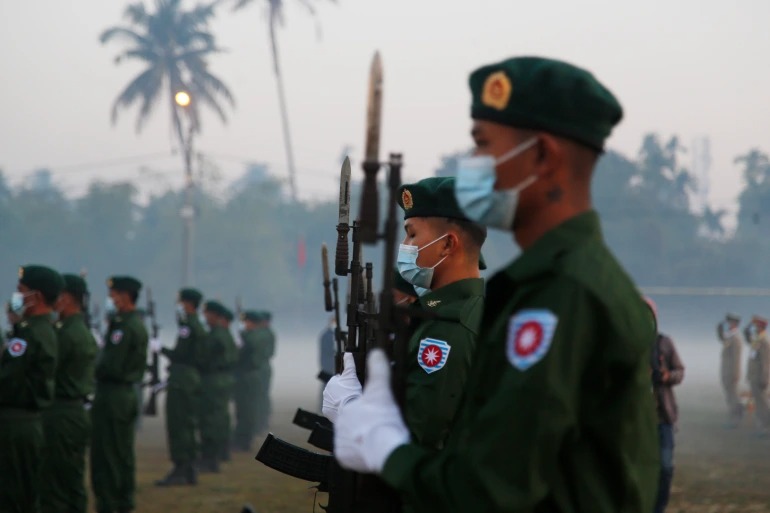
But a couple of hours later, she was awake.
“After hearing loud firing at midnight, I felt worried,” she told Al Jazeera, recalling how she planned to gather up her four children and take them somewhere safe.
But then, an artillery shell plunged through the thatch roof of their bamboo home. “My eyes went blurry,” she remembered. “When I could open my eyes, I saw my youngest son lying on the floor and bleeding profusely.”
Maung Ko Naing, just seven years old, was moaning in pain. He told his mother that his back and his stomach hurt.
Bu Wine and her husband tried to get the boy to hospital, but it was too dangerous to send an ambulance because of the heavy shelling.
“We carried him by motorcycle to a rural clinic but there wasn’t any health worker, and the child died without receiving any medical treatment, ” she said, sobbing.
Five days later, Myanmar’s military attacked the village again, Bu Wine said, wounding at least four people. Following the shelling, everyone in the village abandoned what was left of their homes and fled to the town of Kyauktaw.
Maung Ko Naing is one of at least five children to have been killed since conflict between the armed Arakan Army and the Myanmar military resumed in early July, amid unrest that has worsened across the country since the generals seized power in a coup in February last year.
Fourteen people are thought to have died in just over two months since fighting resumed in Rakhine, a long-troubled state where the mostly Muslim Rohingya were driven out in a brutal 2017 military crackdown that is now the subject of a genocide trial.
The United Nations in Myanmar said in an update on October 1 that the situation in Rakhine was “of particular concern” because some 17,400 people had been displaced since August and humanitarian aid was being disrupted by new movement restrictions.
“The use of heavy weapons, airstrikes, landmines and mortar shelling has been seen in multiple townships,” the UN report said. “Amid fears about inter-communal tension, arbitrary arrests, indiscriminate attacks and destruction to private property, many people have left their villages.”
The Arakan Army (AA), which is fighting for greater autonomy for the state, now claims to have 30,000 troops and is one of at least three armed groups, including the Arakan Rohingya Salvation Army (ARSA), that are active in northern Rakhine.
Just before Myanmar’s national election in November 2020, the AA agreed to a truce. After the military seized power, the AA’s political wing, the United League of Arakan (ULA), took the opportunity to extend and entrench its power in Rakhine.
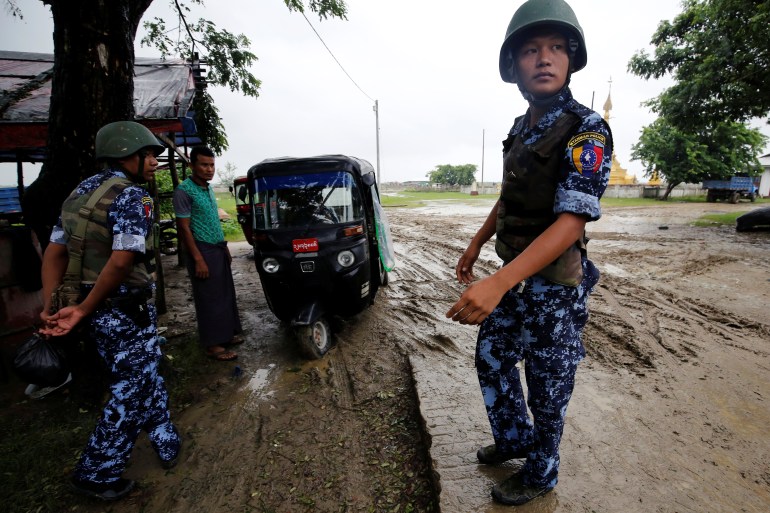
But, facing rebellions on multiple fronts across the country, and with the AA thought to have grown closer to anti-coup forces, the generals have become wary of allowing the group a power base.
On July 4, tensions exploded into the open after the armed forces mounted an air raid on an AA base in territory controlled by the Karen National Union in southeastern Kayin state, killing at least six soldiers and injuring many others.
Nearly two weeks later, the AA retaliated, attacking the military in northern Maungdaw township close to the Bangladeshi border, killing at least four, injuring many others, and taking at least 14 people captive.
Supplies held up
Since then, a series of armed clashes have taken place across Rakhine and in the neighbouring township of Paletwa in Chin State.
Between August 13 and September 23, analysts have catalogued a total of 37 locations, including 30 in Rakhine and seven in Paletwa, where the two groups have been involved in armed confrontations.
On September 16, about two months after fighting resumed, the military regime blocked the United Nations and international non-governmental organizations from accessing six townships in northern Rakhine state for an unspecified period of time.
On that day, a local charity group led by prominent Rakhine social worker Ann Thar Gyi was shot at by Myanmar troops at a security checkpoint in the town of Mrauk-U as he was on his way to provide relief to people displaced by the fighting.
“At first, they [Myanmar soldiers] checked our identification cards calling through the phone to those higher up,” the 42-year-old told Al Jazeera. As they sat there and the minutes ticked by, Ann Thar Gyi feared they would be arrested. They decided it would be better to try and drive off.
“They shot directly at least two more times,” the 42-year-old told Al Jazeera.
Ann Thar Gyi says he now faces charges of spreading “false news” and creating “fear”. Anyone found guilty under the law faces as long as three years in prison, and Ann Thar Gyi is now in hiding.
“This is a targeted threat against social and humanitarian workers in Rakhine,” he said.
Before the military blocked humanitarian agencies in Rakhine, displaced people in northern Rakhine were already struggling to find enough food or put a roof over their heads. The escalating conflict has made matters worse.

A 29-year-old from Maungdaw township said he and other residents had been unable to travel since the fighting resumed in earnest, while supplies of food had been hampered by the military’s decision to close the road connecting Maungdaw with Sittwe, the state capital and the source of much of the township’s food supply.
“We are in a block like house arrest,” a Maungdaw resident who requested anonymity for his own security, told Al Jazeera.
The approach is part of the military’s notorious ‘four cuts’ strategy, which aims to cut off armed groups from their sources of food, funds, information and recruits, even to the detriment of civilians living in the area.
“Because of the blocked supply chain channel of commodities and local transportation, the local Rohingya and Rakhine are suffering tremendously, leading to hunger, starvation, and malnutrition,” Aung Kyaw Moe, a Rohingya activist and adviser to the human rights ministry of the National Unity Government (NUG), established by the politicians the military removed from office, told Al Jazeera.
On September 29, local media reported that the military regime had also restricted the supply of medicines from Yangon to Rakhine state; at least two medical doctors have also been arrested by the military.
Dr Kyaw Thura, one of the detained medical doctors, has been charged under the Unlawful Associations Act.
A 40-year-old medical doctor who has been working for the government hospital in northern Rakhine since 2015 said the military has stopped people from carrying medicines and similar items through their checkpoints. “It has been for nearly two weeks on the ground although there isn’t an official announcement, we are now like soldiers who are fighting in the battle without weapons,” he said.
Civilians targeted
The rising tension has also seen a wave of political arrests.
In early June, soldiers began targeting the townships of Mrauk-U, Sittwe, Kyauktaw, and Ponnagyun, blocking the towns’ gates and conducting regular checks of homes, hotels and guesthouses for AA/ULA members. Dozens of people were arrested and accused of having links with the AA.
As of September 20, at least 140 civilians had been arrested, according to local media, with at least 62 still in detention. The AA has responded by arresting at least 20 military personnel in the areas of Rakhine under its control.
A 29-year-old resident of Maungdaw said the military had told people “to report on AA troop movements”, and warned them “not to post anything nor to post anything on social media or record the movement of Myanmar military personnel”. He preferred not to give his name for fear of reprisals.
As the fighting continues, there is little respite for civilians.
About 600,000 Rohingya, who faced discrimination long before the 2017 crackdown, are living in camps where their movements are restricted.
The new fighting has forced more of those who had managed to stay in their own homes to flee, and increased the risk for those who remain in their villages.
“Rohingya people are trapped between two armed groups,” said Aung Kyaw Moe, the Rohingya activist.
“The AA is expanding its territory of control south of Buthidaung, which is a good thing so far as weakening the junta, but AA troops stationing near Rohingya villages offer an opportunity [for the military] to carry out indiscriminate attacks and continue their unfinished business of genocide.”
Some Rohingya have also found themselves under attack by the AA, according to another Rohingya activist Nay San Lwin. He accuses the AA of laying landmines in the village Guda Pyin, where one man was killed on October 7, and of shooting dead a Rohingya man in the same village the next day.
For Rohingya and Rakhine alike, everyday life has become a battle for survival.
Hla May from Mrauk-U township said her three-year-old daughter was injured while playing with her friend after their house was caught in a military attack on September 28.
“Two bombs fell to our house, and one hasn’t exploded yet,” she said, recalling the incident, which happened as she was cooking lunch.
“We are not safe, my child wakes at midnight and cries every day now after [the house] was hit by the bombs.”
SOURCE: AL JAZEERA

